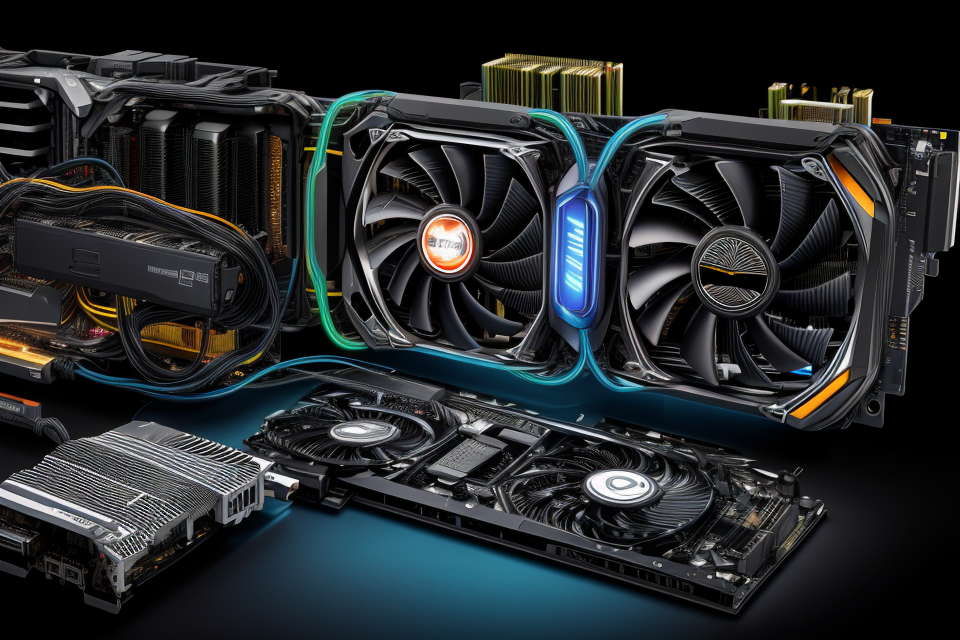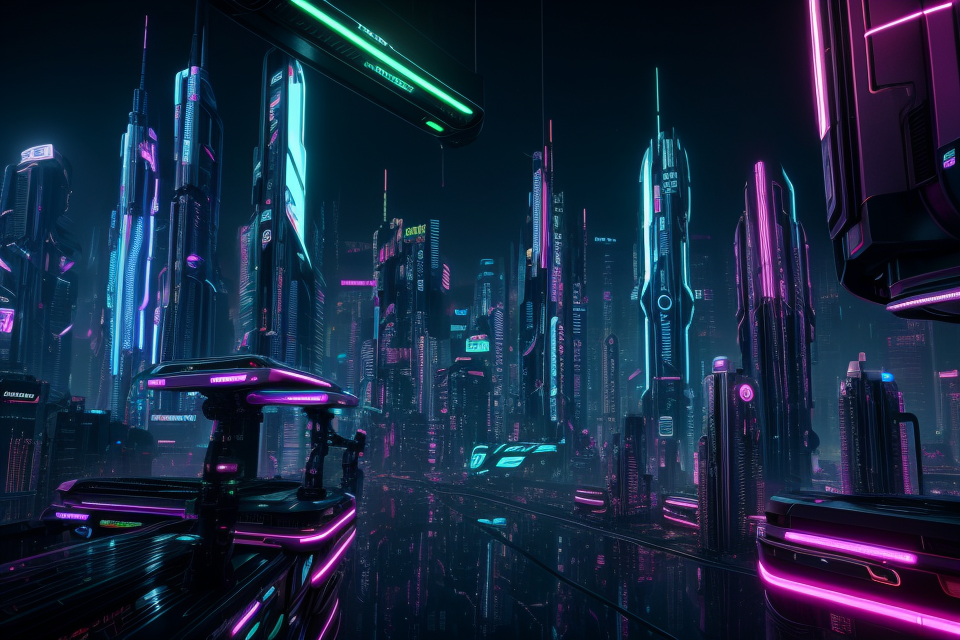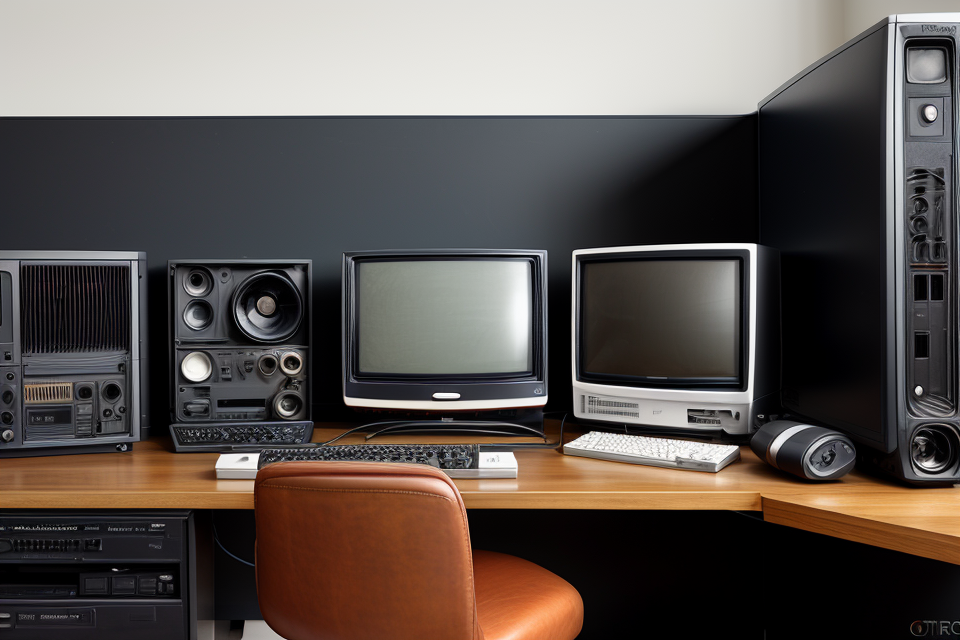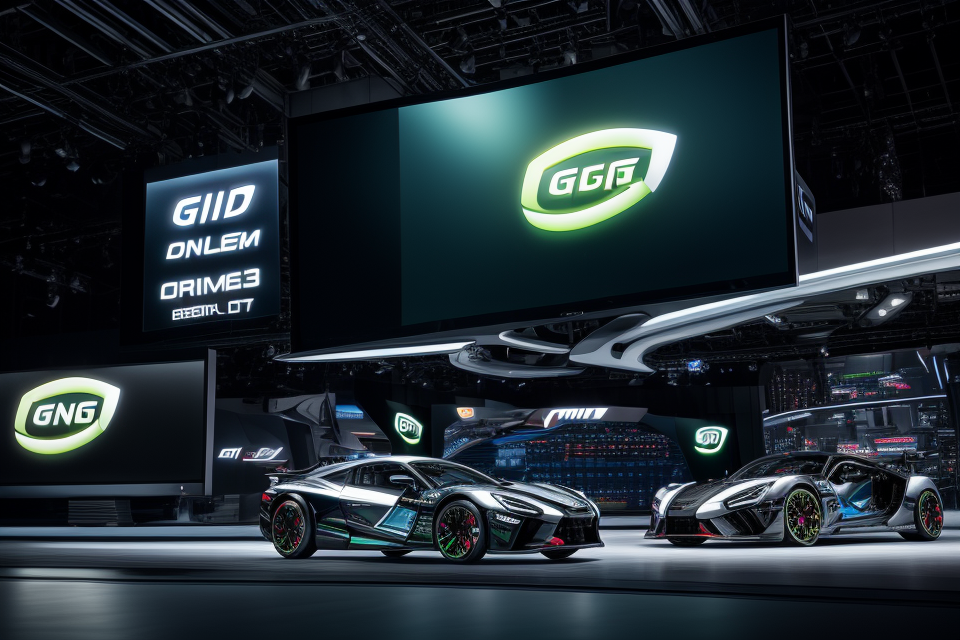
A graphics card, also known as a display card or video card, is an essential component of a computer system that is responsible for rendering images and videos on the screen. It is a hardware device that is specifically designed to accelerate the creation and display of visual content. The graphics card is connected to the motherboard of a computer and is responsible for converting the data from the CPU into images that can be displayed on the screen. In today’s world, where technology is an integral part of our lives, the role of graphics cards has become more important than ever before. From gaming to video editing, from 3D modeling to virtual reality, graphics cards play a crucial role in enhancing the overall performance of a computer system.
A graphics card, also known as a GPU (Graphics Processing Unit), is a hardware component designed to accelerate the creation and rendering of images and video. It is responsible for producing the visual output that is displayed on a computer screen. Graphics cards are essential for tasks such as gaming, video editing, and 3D modeling, as they can handle complex calculations and rendering tasks more efficiently than the CPU (Central Processing Unit). The performance of a graphics card can have a significant impact on the overall performance of a computer, especially when it comes to tasks that require intensive graphics processing. Additionally, advancements in graphics card technology have led to the development of new technologies such as virtual reality and augmented reality, which have the potential to revolutionize various industries.
Understanding Graphics Cards
The Basics of Graphics Cards
A graphics card, also known as a video card or display card, is a hardware component that is responsible for rendering images and videos on a computer screen. It is designed to handle the complex calculations required to produce high-quality visuals in real-time.
While the central processing unit (CPU) is responsible for executing general-purpose tasks, the graphics card is specifically designed to handle the computational demands of graphical applications such as gaming, video editing, and 3D modeling.
The graphics card is a critical component in modern computing as it enables the creation and display of rich multimedia content. It plays a vital role in enhancing the overall performance of a computer system, particularly in tasks that require intensive graphics processing.
In summary, a graphics card is a specialized hardware component that is designed to handle the complex calculations required for rendering images and videos on a computer screen. It is a critical component in modern computing, playing a vital role in enhancing the overall performance of a computer system, particularly in tasks that require intensive graphics processing.
Types of Graphics Cards
Graphics cards, also known as video cards or display adapters, are electronic components that are responsible for rendering images and videos on a computer screen. They come in different types, each designed to meet specific needs and requirements. Here are the three main types of graphics cards:
Integrated Graphics Cards
Integrated graphics cards are those that are built into the motherboard of a computer. They share the memory of the computer with the CPU and are used for basic graphics rendering tasks. They are typically less powerful than dedicated graphics cards but are sufficient for basic tasks such as web browsing, video playback, and basic gaming. Integrated graphics cards are often used in laptops and low-end desktop computers where space and power consumption are critical factors.
Dedicated Graphics Cards
Dedicated graphics cards are separate components that are installed in a computer’s PCIe slot. They have their own memory and are designed specifically for graphics rendering tasks. Dedicated graphics cards are more powerful than integrated graphics cards and are suitable for tasks such as gaming, video editing, and 3D modeling. They can offload the workload from the CPU, resulting in smoother graphics and faster rendering times. Dedicated graphics cards come in different sizes and power levels, ranging from low-end models for basic gaming to high-end models for professional use.
Mobile Graphics Cards
Mobile graphics cards are designed for use in laptops and other portable devices. They are typically less powerful than their desktop counterparts but are designed to be more power-efficient to accommodate the limited power supplies of laptops. Mobile graphics cards are often used in laptops that are designed for gaming or other graphics-intensive tasks. They are also used in tablets and other mobile devices that require graphics rendering capabilities.
In summary, graphics cards come in different types, each designed to meet specific needs and requirements. Integrated graphics cards are built into the motherboard and are suitable for basic tasks, while dedicated graphics cards are separate components that are installed in a computer’s PCIe slot and are more powerful and suitable for gaming, video editing, and other graphics-intensive tasks. Mobile graphics cards are designed for use in laptops and other portable devices and are typically less powerful but more power-efficient.
Factors to Consider When Choosing a Graphics Card
When selecting a graphics card, there are several factors to consider. These factors can significantly impact the performance and overall experience of using the graphics card. Here are some key factors to consider when choosing a graphics card:
| Aspect | Description |
|---|---|
| Budget | Determine how much you are willing to spend on a graphics card. |
| Compatibility | Ensure that the graphics card is compatible with other components in your system. |
| Gaming needs | Consider the specific gaming needs you have, such as the type of games you play and the level of detail required. |
| Workload requirements | Consider the workload requirements of the graphics card, such as the amount of data that needs to be processed and the complexity of the tasks. |
Budget is a crucial factor to consider when choosing a graphics card. It is essential to determine how much you are willing to spend on a graphics card before making a purchase. Graphics cards can range from affordable options to high-end models that can be quite expensive. It is important to set a budget and find a graphics card that fits within that budget while still meeting your needs.
Compatibility is another critical factor to consider when choosing a graphics card. It is essential to ensure that the graphics card is compatible with other components in your system, such as the motherboard and CPU. It is also important to check the graphics card’s power requirements and make sure that your power supply unit (PSU) can handle the demands of the graphics card.
Gaming needs are also an essential factor to consider when choosing a graphics card. If you are a gamer, you will want to consider the specific gaming needs you have, such as the type of games you play and the level of detail required. Some games may require a high-end graphics card with advanced features, while others may be compatible with more affordable options.
Workload requirements are also a critical factor to consider when choosing a graphics card. It is essential to consider the workload requirements of the graphics card, such as the amount of data that needs to be processed and the complexity of the tasks. If you use your computer for tasks such as video editing or 3D modeling, you will want to choose a graphics card that can handle the demands of these tasks.
In conclusion, there are several factors to consider when choosing a graphics card. Budget, compatibility, gaming needs, and workload requirements are all essential factors to consider when selecting a graphics card. By considering these factors, you can find a graphics card that meets your needs and provides the performance you require.
Impact of Graphics Cards on Technology
Gaming
Graphics cards play a crucial role in the gaming industry. The performance of a graphics card directly affects the quality and smoothness of the graphics in a game. A high-end graphics card can handle complex graphics and animations, resulting in a seamless and immersive gaming experience. On the other hand, a low-end graphics card may struggle to handle basic graphics, resulting in laggy and pixelated graphics.
Popular games that rely heavily on graphics cards include first-person shooters, racing games, and open-world games. These games require a lot of processing power and memory to render complex graphics and animations in real-time. Therefore, having a powerful graphics card is essential for a smooth and enjoyable gaming experience.
The future of gaming with advanced graphics cards is exciting. With the development of new technologies such as virtual reality and augmented reality, graphics cards will need to become even more powerful to handle the complex graphics and animations required for these experiences. Additionally, advancements in graphics cards will allow for more realistic and detailed graphics in games, providing players with an even more immersive experience.
Overall, the impact of graphics cards on gaming is significant. A powerful graphics card can enhance the overall gaming experience by providing smooth and seamless graphics, while a low-end graphics card can hinder the experience by causing lag and pixelation. As technology continues to advance, the role of graphics cards in gaming will become even more important.
Virtual Reality and Augmented Reality
Graphics cards play a crucial role in enabling immersive virtual reality (VR) and augmented reality (AR) experiences. They handle the complex calculations required to render realistic graphics and animate 3D environments, characters, and objects.
Current trends in VR and AR technology
The current trends in VR and AR technology include the development of more advanced hardware, such as higher resolution displays, faster processors, and improved sensors. These advancements have enabled the creation of more realistic and immersive VR and AR experiences.
One of the most popular VR platforms is the Oculus Rift, which was acquired by Facebook in 2014. The platform has been used to create a range of VR experiences, from gaming to education and tourism. Another popular VR platform is the HTC Vive, which offers a more immersive experience through its room-scale tracking technology.
Future of VR and AR with advanced graphics cards
The future of VR and AR is likely to be shaped by the development of more advanced graphics cards. These cards will be capable of handling even more complex calculations and rendering even more realistic graphics. This will enable the creation of even more immersive VR and AR experiences, with greater detail and more realistic physics.
One area where VR and AR are likely to have a significant impact is in the field of entertainment. VR and AR games and experiences are already becoming more popular, and it is likely that they will become a major part of the gaming industry in the future. They may also be used to create new forms of storytelling and art, allowing users to experience immersive and interactive narratives.
Another area where VR and AR are likely to have an impact is in education and training. VR and AR can be used to create realistic simulations of real-world environments, which can be used to train professionals in a range of fields, from medicine to engineering. They may also be used to create more engaging and interactive educational experiences for students.
In conclusion, graphics cards play a critical role in enabling VR and AR experiences. As these technologies continue to evolve, it is likely that they will have a significant impact on a range of industries, from entertainment to education and training.
Video Editing and Graphic Design
Graphics cards play a crucial role in video editing and graphic design, enabling users to create high-quality visual content with ease.
- How graphics cards impact video editing and graphic design
Graphics cards impact video editing and graphic design by providing the processing power needed to handle large files and complex designs. With powerful graphics cards, users can work with high-resolution video footage and large images without experiencing lag or slowdowns. Additionally, graphics cards can accelerate rendering times, allowing users to complete projects more quickly. - Popular software that require powerful graphics cards
Several popular video editing and graphic design software require powerful graphics cards to function optimally. Examples include Adobe Premiere Pro, Final Cut Pro, and Autodesk Maya. These software applications are used by professionals in the film, television, and gaming industries, among others. - Future of video editing and graphic design with advanced graphics cards
As technology continues to advance, so too will the capabilities of graphics cards. In the future, we can expect to see even more powerful graphics cards that will enable users to create even more complex and realistic visual effects. This will open up new possibilities for video editors and graphic designers, allowing them to push the boundaries of what is possible and create truly groundbreaking content.
Cryptocurrency Mining
Cryptocurrency mining is the process of verifying transactions and adding new blocks to the blockchain. It requires significant computational power, and graphics cards have become a popular choice for mining due to their ability to handle complex mathematical calculations.
Here are some details on how graphics cards are used for cryptocurrency mining:
- How graphics cards are used for cryptocurrency mining: Graphics cards are used to perform the complex calculations required to mine cryptocurrencies. The process involves solving complex mathematical problems, which requires a large amount of computational power. Graphics cards are designed to handle these types of calculations, making them an ideal choice for mining.
- Popular cryptocurrencies that can be mined with graphics cards: Some of the most popular cryptocurrencies that can be mined with graphics cards include Bitcoin, Ethereum, and Monero. However, there are many other cryptocurrencies that can be mined using graphics cards, such as Litecoin, Zcash, and Dash.
- Future of cryptocurrency mining with advanced graphics cards: As the popularity of cryptocurrencies continues to grow, so does the demand for more powerful graphics cards. Advanced graphics cards with higher performance capabilities are being developed to meet this demand, and they are expected to play a significant role in the future of cryptocurrency mining. However, it’s worth noting that the use of graphics cards for mining can also have a negative impact on the availability and pricing of these cards for other uses, such as gaming or graphics design.
Other Applications
- Advancements in Artificial Intelligence and Machine Learning
- Graphics cards play a crucial role in the development of AI and machine learning algorithms. They are capable of processing large amounts of data quickly, which is essential for training these algorithms. The increased computing power provided by graphics cards enables researchers and developers to create more sophisticated models and algorithms that can analyze and make predictions based on complex data sets.
- With the increasing demand for AI and machine learning applications in various industries, the need for powerful graphics cards has grown significantly. As a result, the market for high-performance graphics cards has expanded, and new technologies are being developed to meet the demand.
- For instance, NVIDIA’s GPUs are widely used in AI and machine learning applications due to their ability to handle parallel processing and high-speed memory access. Their CUDA technology allows developers to write programs that can run on their GPUs, enabling faster and more efficient processing of data.
- Virtual Reality and Augmented Reality
- Graphics cards are essential for the smooth operation of VR and AR systems. They are responsible for rendering the graphics and animations that create a realistic and immersive experience for users. High-performance graphics cards with high memory bandwidth and fast processing speeds are required to ensure that the graphics are rendered smoothly and without lag.
- VR and AR applications require complex calculations and rendering of graphics in real-time, making them demanding on a computer’s hardware. As a result, the need for powerful graphics cards has become more important as VR and AR technology continues to advance.
- The use of graphics cards in VR and AR applications has the potential to revolutionize industries such as gaming, entertainment, and education, by providing users with an immersive and interactive experience.
- Other Applications
- Graphics cards are also used in other applications such as scientific simulations, financial modeling, and medical imaging. These applications require high-performance computing power to process large amounts of data and perform complex calculations.
- The use of graphics cards in these applications has led to faster processing times and more accurate results, enabling researchers and professionals to make better-informed decisions.
- As technology continues to advance, the demand for graphics cards in various applications is expected to increase, driving the development of new technologies and innovations in the field.
FAQs
1. What is a graphics card?
A graphics card, also known as a display card, video card, or GPU (Graphics Processing Unit), is a type of expansion card that is installed in a computer to generate graphical images and videos. It is responsible for rendering images and processing the graphical data that is displayed on the computer screen.
2. How does a graphics card impact technology?
A graphics card plays a crucial role in technology as it enhances the overall performance of a computer, particularly in tasks that require intensive graphical processing such as gaming, video editing, and 3D modeling. With the help of a graphics card, these tasks can be performed more efficiently and effectively, resulting in smoother and more realistic graphics. Additionally, the use of high-end graphics cards can also enhance the visual experience of virtual reality and augmented reality applications.
3. What are the different types of graphics cards?
There are various types of graphics cards available in the market, including integrated graphics cards and discrete graphics cards. Integrated graphics cards are built into the motherboard and are used for basic graphical processing tasks, while discrete graphics cards are separate cards that are installed in the PCIe slot and are designed for more advanced graphical processing tasks. Some of the popular graphics card brands include NVIDIA and AMD.
4. How do I know if my computer needs a graphics card upgrade?
If you notice that your computer is taking longer to load graphics-intensive applications or games, or if the graphics appear choppy or pixelated, it may be an indication that your computer needs a graphics card upgrade. Additionally, if you are experiencing slow performance in other areas of your computer, such as slower boot times or slower application performance, a graphics card upgrade may also be beneficial.
5. How do I choose the right graphics card for my computer?
When choosing a graphics card for your computer, it is important to consider the compatibility of the card with your current system, as well as the intended use of the card. For example, if you are a gamer, you may want to choose a graphics card that is designed specifically for gaming, such as those with high frame rates and fast refresh rates. If you are a content creator, you may want to choose a graphics card that is designed for video editing and rendering, such as those with high memory bandwidth and CUDA cores.


